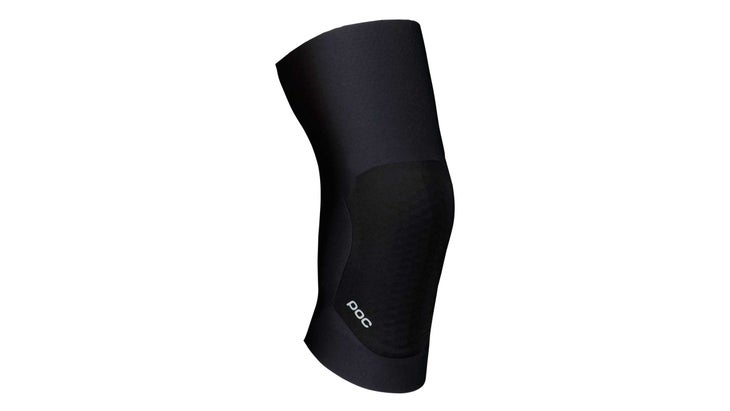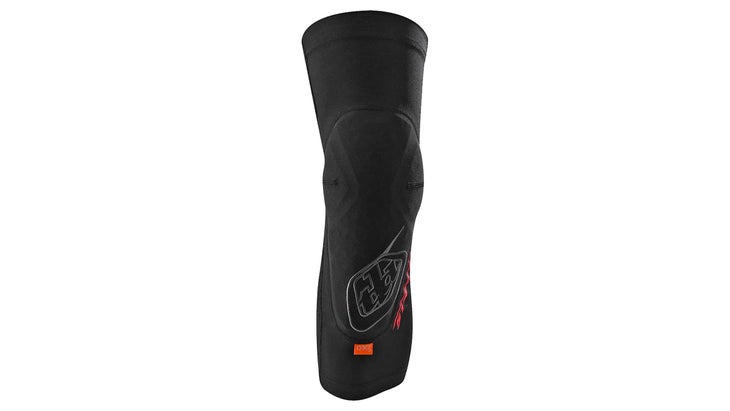There are endless choices when it comes to mountain bike knee protection. We tested ten options while running hot laps on local trails, barreling down bike parks, and grinding out all-day alpine adventures. At the end of the day, these four knee pads stood out as the most pedal-friendly options thanks to their compact size, versatility, and comfort.
All gear in this guide was tested by multiple reviewers. If you buy through our links, we may earn an affiliate commission. This supports our mission to get more people active and outside. Learn more.

Best Value
Fox Launch D30
$76 at Backcountry $67 at Amazon
Weight: 207 g
Size Range: S -L
Pros and Cons
⊕ Secure fit
⊕ Good front and side coverage
⊗ Runs hot
The D30 Launch are Fox’s Level 1 certified, medium-gauged knee guards made for all-day pedaling. They feature a slip-on design with additional Velcro fasteners at the top and bottom for a secure fit. Testers reported that they fit well and stayed in place while pedaling, but airflow was not a strong point—they don’t breathe as well as the Troy Lee Designs or POC options on this list.
That said, these are great bang for your buck knee guards that offer just enough protection to give you the confidence to go hard and are comfortable enough to leave on for modest climbs.

Best Airflow
POC VPD Air Flow Knee Pad
$140 at Backcountry $140 at Amazon $140 at POC
Weight: 110 g
Size Range: XS-XL
Pros and Cons
⊕ Super lightweight
⊕ Exceptional breathability
⊗ Minimal coverage—not enough for any rowdy technical riding
⊗ Expensive
The VPD Air Flow Knee Pads are POC’s newest lightweight knee guards that utilize a minimalist, slim sleeve design for just enough protection to encourage pushing it on more aggressive trail rides. These pads feature four inches of elastic grip on the inside top edge, which testers reported helped them stay in place.
Best of all, these pads are made from a very light and breathable material which prevented them from cooking our knees—one tester has since made the VPD Air Flow her go-to knee pads for shorter rides thanks to their superior breathability. However, we did find their comfort limits on longer rides. We recommend sizing down and limiting this low-profile option to riding flowy, less technical trails.

Most Comfortable
Akta Trail Knee Pad
Weight: 183 g
Size Range: XS-XXL
Pros and Cons
⊕ Breathable
⊕ Very comfortable
⊗ Some minor shin rubbing at the bottom of the pad
⊗ Run large
These knee guards were a tester favorite for their comfortable and pedal-friendly fit. The slip-on design features a mesh back that offers excellent breathability and uses compression elastic and silicone grippers at the top and bottom to prevent slippage while pedaling. That, combined with D30 inserts and EVA foam padding for protection that doesn’t get in the way while pedaling, had testers forgetting that they were wearing any pads at all even during longer rides.
According to testers, they’re everything you always wanted in a low-profile, pedal-friendly knee pad—comfortable, breathable, and burly enough for 80 percent of trails. One note: We found these to run large and recommend sizing down.

Best for Long Rides
Troy Lee Designs Stage Knee Guard
$95 at Backcountry $95 at Amazon
Weight: 320 g
Size Range: XS/S, M/L, XL/2XL
Pros and Cons
⊕ Good breathability
⊕ Comfortable to pedal in
⊕ Compact (easy to stow or fold up)
⊗ Minimal side protection
⊗ Limited size options
The Troy Lee Designs Stage knee guard is a game-changer for those who have been hesitant to wear knee pads because they tend to get in the way of pedaling. They’re a sleeve-style guard, with silicone gripper elastic strips to hold them snugly in place and a highly breathable mesh back, which testers appreciated on hotter days or long climbs.
In fact, these pads are now my top choice for longer rides since they’re lightweight and not too bulky, offering just enough protection for the more technical trails in my neighborhood. Thanks to their compact size, they’re also easily stashed away mid-ride after you’ve cruised through the techy stuff. “These knee guards are easy to throw in a pack and have become my favorite addition to all my rides,” added another tester.
They’re also durable—my set has held up well for two seasons of consistent riding with only minor wear (including the silicone). Simply put, they add that layer of confidence and protection that we all need.
How to Choose Knee Pads
Before you purchase knee pads, it’s important to consider what type of riding you’ll be doing. If you spend most of your time in the bike park and riding downhill, technical trails, you’ll want beefier pads that provide ample protection—comfort and breathability are secondary. On the other hand, if you’ll mostly be riding cross-country trails with lots of uphill vertical, you’ll want knee pads that are lighter and more breathable to help you stay cool and comfortable.
It’s always a good idea to try on a pair in your local bike shop to see which size fits you best and whether you can comfortably bend your knees in them. The last thing you want is a pair of knee pads that are too small and squeeze your legs, or a pair that slips off your knees mid-ride. Sizing can vary depending on the brand, so know that a size medium in one brand might fit differently than a size medium in another brand.
Knee pads are a category that we don’t suggest you buy pre-owned, since previous wear and tear that isn’t obvious to the eye can make them considerably less protective.
How We Tested
- Number of testers: 4
- Number of pads tested: 10
- Longest ride: 3 hours
We enlisted four testers and the editors at our sister title, Pinkbike, to pedal in ten different knee guards to help us determine which offered the best mix of protection, comfort, and breathability. All testers are avid mountain bikers who spend a lot of time in the saddle riding, coaching, or racing. The majority of the testing was done in Hood River, Oregon in the fall of 2023, with some products previously reviewed as part of Pinkbike projects earlier in the year.
The main trails in Hood River include the iconic Post Canyon system, just on the outskirts of town, which offers a vast network of forested trails dropping 3,000 vertical feet from the top point, with a mix of jumps, drops, berms, and rocks; to the 44 Trails, about an hour south of town on the flanks of Mount Hood. The infamous Gifford Pinchot National Forest is just across the Columbia River on the Washington side, with an abundance of riding opportunities. Fall is the perfect time for testing in the PNW, as the dry summer heat fades away and the moisture makes for some epic trail conditions and a variety of temperatures, from below-freezing to the mid-eighties.
Meet Our Testers
Nikki Rohan has been mountain biking for close to 20 years, and testing mountain biking gear for Pinkbike for almost a decade. She resides in Hood River OR with her husband, two teenagers, a 1-year old late family edition, two dogs and a grumpy cat. When she is not working, cooking or parenting, you will find her on the local trails.
Megan Barton started riding mountain bikes in 2017 after spending many years running silly long distances on trails. She has years of coaching for both Dirt Series and Brave Endeavours, a Hood River based program. When she’s not on two wheels, you can find her running, rafting, hiking, or working her day job as a nurse practitioner.
Bekah Rottenberg is the founder and head coach of Brave Endeavors: MTB Skills and Strength Training. She lives and works in Hood River, OR and can most commonly be found on her bike coaching kids or adults.
